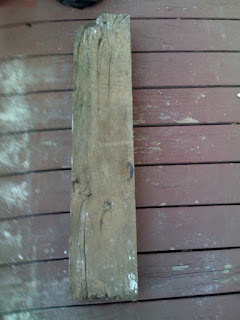

I often read of people worried about running "old wood"through their Jointers or planers for fear of damage from unknown objects. What they miss is some of the finest woods that may ever grace their shop bench. I have a metal detector, and a craftsman jointer, planer that I use for nearly all my found wood needs. The metal detector finds those BB's fence metal and old nails deep in the wood the eye misses. My blades on my craftsman are about 35.00 a set of three and I gladly let them become nicked and cut in the cheapest way to get wood around.
Recently I was hunting on a property in Woodland. There sat a 6x6 about 4 feet long. The classic greying of the oldgrowth lumber that long long ago was a fence post in a large field. Now turkeys are wadering around (The reason I discovered the wood) the posts as well as a 10x10 and a few other scrap redwood pieces. Often on old fence is replace either in front or back with a new metal wire fence leaving the old one in place. Some land owners are happy to part with the old fence and most of the posts 4x4 and larger are solid from the ground up so it can be a win/win if you just go and ask about the wood.
Most of the redwood I find looks like a milk chocolate bar, brown but in a lighter shade. Add some bio-shield ( I love that stuff) or lindseed oil and it can darken up like the deep browns of walnut.
I often think that many fear the nicking of a blade, but one can certainly find a cheap jointer or planer (mine was 100.00) to take one for the team if needed. Even among other woodworkers I often have them wondering what wood I am using. Nearly all of my fir or redwood is over 100 years old when it was initially milled. While there are imperfections, nail holes and cracks all this can be over looked in many applications.
I have made boxes, yoga blocks, trimmed a bathroom out, made flooring, made benches and on and on. All at little cost ( I even sold some milled redwood to the nieghbor to cover new manufactured beams in a beatiful house from the 20's) I can say there is nearly no way to tell that the beams are not massive redwood timbers covering as well a stove pipe.
So when in the country or near those old houses that are being ruined ( I mean remodeled) remember that you can grab windows, doors, 2xs and anything else the contractor is " fixing"
Even a deck from 20 - 30 years ago has prized timber compared to the garbage you will find at the local lumber yard.
So joint, or cut off that paint if it is there. And get that timber rolling in your shop.
And remeber some of that wood has been in the rain for a 100 years off and on. I sticker it mill it after a while then bring it into the house and stack it (like a good unmarried guy can do).
Nearly every board I cut would cost more to buy than a set of blades costs me. For me the decision is easy.
Now start looking for those nuggets in the rough.

















